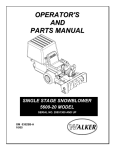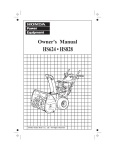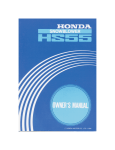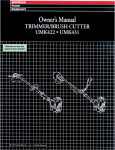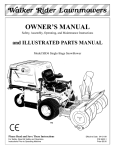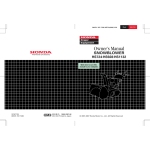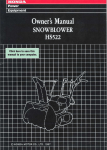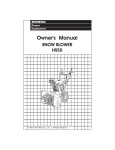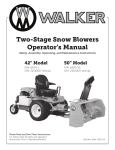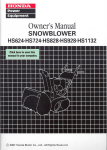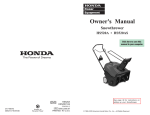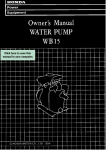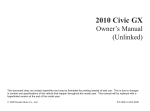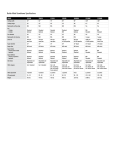Download Honda HS622 User's Manual
Transcript
Owner's Manual SNOWBLOWER HS622 ©1996 Honda Motor Co., Ltd.—All Rights Reserved The engine exhaust from this product contains chemicals known to the State of California to cause cancer, birth defects or other reproductive harm. 1 Thank you for purchasing a Honda snowblower. We want to help you get the best results from your new snowblower and to operate it safely. This manual contains the information on how to do that; please read it carefully. This owner’s manual describes the operation and maintenance of HONDA snowblower: HS622 All information in this publication is based on the latest product information available at the time of printing. Honda Motor Co., Ltd. reserves the right to make changes at any time without notice and without incurring any obligation. No part of this publication may be reproduced without written permission. This manual should be considered a permanent part of the snowblower and should remain with it if it is resold. Safety Messages Your safety and the safety of others is very important. We have provided important safety messages in this manual and on the snowblower. Please read these messages carefully. A safety message alerts you to potential hazards that could hurt you or others. Each safety message is preceded by a safety alert symbol 8. and one of three words: DANGER, WARNING, or CAUTION. These mean m You WILL be KILLED or SERIOUSLY follow instructions. HURT if you don’t B You CAN be KILLED or SERIOUSLY follow instructions. B HURT if you don’t You CAN be HURT if you don’t follow instructions. Each message tells you what the hazard what you can do to avoid or reduce injury. Damage Prevention Messages You will also see other important word NOTICE. messages is, what can happen, that are preceded and by the This word means: ( Your snowblower or other property you don’t follow instructions. The purpose snowblower, could be damaged of these messages is to help prevent other property, or the environment. damage if to your CONTENTS 3 SAFETY ........................................................................................................ 3 .................................................................. SAFETY LABEL LOCATIONS 4 .......................................................................... SAFETY INFORMATION .7 COMPONENT IDENTIFICATION.. .............................................................. 8 .................................................................................................. CONTROLS 8 Engine Switch .......................................................................................... 8 ................................................................................................. Fuel Valve 9 .............................................................................................. Choke Lever 9 ............................................................................................... Starter Grip .lO ........................................................................................ Throttle Lever 10 Shift Lever .............................................................................................. 11 ........................................................................................... Chute Guide ................................................................................ .ll Drive Clutch Lever 12 Auger Clutch Lever ................................................................................ ........................................................................ .12 Height Adjustment Bolt 13 Skid Plate and Scraper .......................................................................... Handle Height Adjusting Bolt ............................................................... :: PRE-OPERATION CHECK.. ........................................................................ 14 Engine Oil ............................................................................................... 15 Fuel ......................................................................................................... 18 Auger Bolts ............................................................................................. 18 Other Checks .......................................................................................... 19 STARTING THE ENGINE ........................................................................... 22 SNOWBLOWER OPERATION ................................................................... 22 Operating the Controls .......................................................................... 26 Clearing Snow ........................................................................................ 28 High Altitude Operation ........................................................................ -29 STOPPING THE ENGINE .......................................................................... 30 MAINTENANCE ......................................................................................... 30 .......................................................... The Importance of Maintenance 31 Maintenance Safety ............................................................................... .32 Proper Maintenance is the Owner’s Responsibility .......................... 33 Maintenance Schedule .......................................................................... 34 ....................................................................................................... Tools ................................................................................ .35 Engine Oil Change 36 Spark Plug Service ................................................................................. 38 ................................................................................... Track Adjustment 39 ............................................................... Inspection Auger and Blower 40 ................................................................................................... STORAGE . TROUBLESHOOTING.. SPECIFICATIONS.. ............................................................................................................. .46 WARRANTY SERVICE INFORMATION ................................................... 47 ......................................................................................................... INDEX 2 SAFETY SAFETY LABEL LOCATIONS These labels warn you of potential injury. Read them carefully. hazards that can cause If a label comes off or becomes hard to read, contact Snowblower dealer for a replacement. your serious Honda 3 SAFETY INFORMATION Most accidents with snowblowers can be prevented if you follow all instructions in this manual and on the snowblower. The most common hazards are discussed below, along with the best way to protect yourself and others. Always make a pre-operation check (pages 14 thru 18 ) before you start the engine. You may prevent an accident or equipment damage. Honda snowblowers are designed to give safe and dependable service if operated according to instructions. Read and understand this Owner’s Manual before operating the snowblower. Failure to do so could result in personal injury or equipment damage. Before operating the snowblower, inspect the area in which you are going to clear snow. Remove debris and other obstacles the snowblower might strike or throw as that may cause injury or damage to the snowblower. Inspect the snowblower before operating it. Repair any damage and correct any malfunction before operation. If you hit an obstacle while operating the snowblower, stop the engine immediately, and check for damage. Damaged equipment may increase the possibility of injury during operation. Do not use the snowblower when visibility is poor. Under conditions of poor visibility, there is a greater risk of striking an obstacle or causing injury. Never use the snowblower to clear snow from a gravel road or driveway, as rocks may be picked up and ejected. They may cause iniurv to bvstanders. l l l l l l Adjust the snow discharge chute to avoid hitting the operator, bystanders, windows, and other objects with ejected snow. Stay clear of the snow discharge chute while the engine is running. Children and pets must be kept away from the area of operation avoid injury from flying debris and contact with the snowblower. to To avoid overturning, be careful when changing the direction of the snowblower while operating it on a slope. Do not use the snowblower to remove snow from roofs. The snowblower may overturn on steep slopes if left unattended, causing injury to the operator or bystanders. Know how to stop the snowblower operation of all controls. quickly, and understand the Never permit anyone to operate the snowblower without proper instruction. If people or pets suddenly appear in front of the snowblower while it is in operation, immediately release the auger and drive clutch levers to stop the snowblower and avoid possible injury from rotating auger blades. If the snow discharge chute becomes clogged, stop the engine and use a wooden stick to unclog it. Never put your hand into the snow discharge chute while the engine is running; serious personal injury could result. 5 l l l l l Gasoline is extremely conditions. flammable certain Do not overfill the fuel tank, and make sure the filler cap is closed securely after refueling. Never run the engine in an enclosed or confined area. Exhaust contains poisonous carbon monoxide gas; exposure can cause loss of consciousness and may lead to death. The muffler becomes very hot during operation after stopping muffler while it is hot. snowblower indoors. 6 under Do not smoke or allow flames or sparks where the snowblower is refueled or where gasoline is stored. Allow the engine to cool down before refueling. Refuel in a well-ventilated area with the engine stopped. a while l and is explosive the engine. Let the and remains hot for Be careful not to touch engine cool before storing the the While operating the snowblower, hold the handle firmly, and walk, don’t run. Wear suitable winter boots that resist slipping. COMPONENT IDENTIFICATION ENGINE SWITCH AUG/ER CLUTCH LEVER SNOW CHUTE SHIFT LEVER CHUTE GUIDE / FUEL VALVE STARTER GRIP OIL FILLER CAP Record the frame and engine serial numbers for your reference. Refer to the serial numbers when ordering parts, and when making technical or warranty inquiries (see page 47 ). Frame serial number: Engine serial number: 7 CONTROLS Engine Switch Use the engine switch to STOP the engine. to turn the ignition system ON for starting, and ENGINE SWITCH Fuel Valve The fuel valve opens and closes the fuel line leading from the fuel tank to the carburetor. Make sure that the valve is positioned exactly at either the ON or OFF position. When the snowblower is not in use, always leave the fuel valve in the OFF position to reduce the possibility of fuel leakage. FUEL VALVE If the snowblower is to be transported sure fuel to turn carburetor 8 the flooding valve to the from one location OFF position. and reduce the possibility This to another, will of fuel leakage. be prevent Choke Lever Close the choke when the engine is cold or difficult to start. Starter Grip See page 19 for starting procedures. Pull this grip to start the engine. STARTER GRIP / 9 Throttle Lever Use the throttle lever to select engine the “FAST” position. speed. In normal THROlTLE operation, LEVER Shift Lever Use the shift lever to select drive speed or direction. (1): (2): (3): (4): LOW SPEED HIGH SPEED NEUTRAL REVERSE SHIFT LEVER 1: LOW SPEED N: NEUTRAL 2: HIGH SPEED 10 use Chute Guide The chute guide controls the snow discharge angle and direction. CHUTE GUIDE CHUTE GUIDE Drive Clutch Lever Use the drive clutch lever to propel or stop the snowblower. DRIVE CLUTCH LEVER 11 Auger Clutch Lever Squeezing the auger clutch lever also operates the drive clutch lever; the snowblowing mechanism starts and the snowblower moves forward. Releasing the auger clutch lever stops both the snowblowing mechanism and the forward motion of the snowblower. STOP Height Adjustment AUGER CLUTCH LEVER Bolt Use the bolt for adjusting relation to the tracks. Raise or lower the machine the height to the desired : Hard snow or fine finish LOW MIDDLE : Normal use : Deep snow or for transporting HIGH and angle of the machine position. (See page 22 1 the snowblower. HEIGHT ADJUSTMENT 12 BOLT in Skid Plate and Scraper Adjust the skid plates and scraper for the auger housing ground clearance best suited to your snow removal conditions. (See page 22 ) / SCRAPER Handle Height Adjusting Bolt The handlebars can be set in the high, low or middle position to suit the operator. To change handlebar height, remove the right and left adjusting bolts, align the bolt holes for the desired handlebar height, and reinstall the bolts. Tighten the nuts securely. HANDLE HEIGHT ADJUSTING BOLT 13 Engine Oil Inspection With the snowblower on a level surface, remove the oil filler cap and wipe the dipstick clean. Insert the dipstick into the filler neck, but do not screw it in. Remove the dipstick and check the oil level. If the level is low, ret :ommended oil. fill to the top of the oil filler neck with the OIL FILLER NECK OIL FILLER CAP AND DIPSTICK -20 -30 0 -20 Oil capacity: 40 20 -10 0 50°F 10°C 0.60 !J (0.63 US qt ,0.53 Imp qt) Recommended oil Use 4-stroke motor oil that meets or exceeds the requirements for API service classification SF or SG. Always check the API SERVICE label on the oil container to be sure it includes the letters SF or SG. SAE 5W-30 is recommended for general use. Other viscosities shown in the chart may be used when the average temperature in your area is within the indicated range. (NOTlCEI l l Using nondetergent oil can shorten the engine’s using P-stroke oil can damage the engine. service life, and Running the engine with a low oil level can cause engine damage. 14 Fuel Refueling Fuel tank capacity: 3.5 0 (0.92 US gal, 0.77 Imp gal) Check the fuel level gauge, and refill the tank if the fuel level is low. Gasoline is highly flammable and explosive. You can be burned or seriously injured when handling fuel. l l l Stop the engine and keep heat, sparks, and flames away. Handle fuel only outdoors. Wipe up spills immediately. Refuel in a well-ventilated area before starting the engine. If the engine has been running, allow it to cool. Refuel carefully to avoid spilling fuel. Do not overfill: there should be no fuel in the filler neck. After refueling, tighten the fuel tank cap securely. Never refuel the snowblower inside a building where gasoline fumes may reach flames or sparks. Keep gasoline away from appliance pilot lights, barbeques, electric appliances, power tools, etc. Spilled fuel is not only a fire hazard, it causes environmental Wipe up spills immediately. damage. 1 NOTICE 1 Fuel can damage paint and plastic. Be careful not to spill fuel when filling your fuel tank. Damage caused by spilled fuel is not covered under warranty. FILLER NECK UPPER LIMIT GAUGE -FUEL - 15 Fuel Recommendations Use unleaded gasoline with a pump octane rating of 86 or higher. This engine is desi ned to operate on unleaded gasoline. Unleaded gasoline produces Pewer engine and spark plug deposits and extends exhaust system life. Never use stale or contaminated gasoline Avoid getting dirt or water in the fuel tank. or an oil/gasoline mixture. hear a light “spark knock” or “pinging” Occasionally you ma (metallic rapping noise Y while operating under heavy loads. This is no cause for concern. If spark knock or pin ing occurs at a steady engine speed, under If spark knock or pinging normal load, than e %rands of gasoline. persists, see an aut Rorized Honda servicing dealer. Running the engine with persistent spark knock or pinging can cause engine damage. Running the engine and the Distributor’s by misuse. 16 with persistent spark knock or pinging is misuse, Limited Warranty does not cover parts damaged Oxygenated Fuels Some conventional gasolines are being blended with alcohol or an ether compound. These gasolines are collectively referred to as oxygenated fuels. To meet clean air standards, some areas of the United States and Canada use oxygenated fuels to help reduce emissions. If you use an oxygenated fuel, be sure it is unleaded minimum octane rating requirement. and meets the Before using an oxygenated fuel, try to confirm the fuel’s contents. Some states/provinces require this information to be posted on the pump. The following are the EPA-approved percentages of oxygenates: ETHANOL - (ethyl or grain alcohol) 10% by volume You may use asoline containing up to 10% ethanol by volume. ethanol may be 8 asoline containing marketed under the name “Gasohol”. MTBE (Methyl Tertiary Butyl Ether) 15% by volume You may use gasoline containing up to 15% MTBE by volume. METHANOL ~ (methyl or wood alcohol) 5% by volume You may use gasoline containing up to 5% methanol by volume, as long as it also contains cosolvents and corrosion inhrbitors to protect the fuel system. Gasoline containing more than 5% methanol by volume may cause starting and/or performance problems. It may also damage metal, rubber, and plastic parts of your fuel system. If you notice any undesirable station, or switch to another operating symptoms, brand of gasoline. try another service Fuel system damage or performance problems resulting from the use of an oxygenated fuel containing more than the percentages of oxygenates mentioned above are not covered under warranty. 17 Auger Bolts Check the auger for loose or broken bol,ts. If broken, new ones (page 39 ). replace them with NUT AUGER SHEAR BOLT Other Checks 1. Check all bolts, nuts and other fasteners for security. 2. Check each part for operation. 3.Check the entire machine for any other been caused in previous operation. 18 faults which might have STARTING THE ENGINE Never run the engine in an enclosed or confined .area. Exhaust contains poisonous carbon monoxide gas; exposure can cause loss of consciousness and may lead to death. 1. Turn the engine switch to the ON position. ENGIN,E SWITCH 2. Turn the fuel valve to the ON position. Be sure that the drain knob is tightened securely. FUEL VALVE DRAIN KNOB 19 3. In cold weather and when the engine CLOSE position. is cold, move the choke to the CHOKE LEVER 4. Pull the starter grip lightly until you feel resistance, then pull briskly. [I l l Do not allow the starter grip to snap back against the engine. Return it gently to prevent damage to the starter. Damage may result if the starter grip is pulled while the engine is running. STARTER GRIP 20 5. Let the engine warm up for several minutes. If the choke has been moved to the CLOSE position, gradually move the choke lever to the OPEN position as the engine warms up. CHOKE LEVER --T---- I 21 SNOWBLOWER OPERATION Operating the Controls 1. Adjust the skid plate and scraper and the spark plug cap removed. positions with the engine stopped The skid plate and scraper have three adjusting positions. Select the position according to the surface conditions described in the chart. NOTE: Adjust the height After adjusting nuts securely. equally the height, on both sides. be sure to tighen the adjusting bolts and TO RAISE HEIGHT ADJUSTING HtltiH Operation Regular work Clearing of hard, SCRAPER BOLT I, Scraper Skid Middle position Middle position UPPER Upper position Upper position LOWER Upper position Lower position ADJUSTING BOLT MIDDLE compact snow Clearing of snow covering uneven ground 22 SKID PLATE 2. Start the engine according to the procedures described on page Before operating this equipment you should Safety information on page 4 thru 6 . read and understand 3. Move the throttle for normal lever to the FAST position THROlTLE 19 . the operation. LEVER 4. Move the shift lever to select the desired drive speed. SHIFT LEVER 1: LOW SPEED N: NEUTRAL 2: HIGH SPEED N: NEUTRAL R: REVERSE l l l Be sure to disengage the drive clutch before shifting gears. Be sure to set the shift lever into the groove. Never move the shift lever while the snowblower is in motion. NOTE: Low speed (1) is recommended packed snow. for removing deep or hard- (Drive speed with throttle lever in the fast position) Shift lever “Speed 1 1.12ftki (0.34 m/s) ‘Speed is stated in meters/second 2 R 2.79 ftk (0.85 m/s) 2.79 ft./s (0.85 m/s) and (feet/second). 23 5. With the shift lever in a forward gear, the machine will move and clear snow simultaneously when you squeeze the auger clutch lever. AUGER CLUTCH LEVER 6.To move from one place to another, or to change direction, drive clutch lever without squeezing the auger clutch lever. use the DRIVE CLUTCH LEVER 7.To operate the snow-clearing mechanism without moving the machine, set the shift lever in NEUTRAL, then squeeze the auger clutch lever. SHIFT 24 8.Adjust the snow discharge chute angle and distance as required. l l l guide according to the discharge Adjust the snow discharge chute to avoid hitting the operator, bystanders, windows, and other objects with thrown snow. Stay clear of the snow discharge chute while the engine is running. If the snow discharge chute becomes clogged, stop the engine and use a wooden stick to unclog it. Never put your hand into the snow discharge chute while the engine is running; serious personal injury could result. To move from one place to another, or to change direction, use the drive clutch lever. Using the auger clutch lever will cause the snowblowing mechanism to rotate, possibly resulting in equipment damage or personal injury. 9. Release the auger clutch lever to stop clearing snow or moving. AUGER CLUTCH LEVER 25 Clearing Snow For best efficiency, clear snow before it melts, refreezes, and hardens. Do not use the throttle lever to adjust your forward speed. The throttle lever must remain in the FAST position for good snow-clearing performance. Tips for clearing deep or hard-packed l Clear narrow snow widths. Use 1st (low) gear, and clear narrower cleared path. l widths by overlapping your Clear in steps. If engine speed decreases in deep, heavy snow, use forward motion intermittently to allow the engine to resume full speed and clear out the auger: 1. Release the auger clutch lever, then move the shift lever to NEUTRAL. 2. Squeeze the auger clutch lever, and allow the engine to resume full speed and clear out the auger. 3. Release the auger clutch lever, then move the shift lever to 1st (low) gear. 4. Squeeze the auger clutch lever and resume snow clearing. 26 l l Clear with back-and-forth motions If the snow is so hard that the snowblower tends to ride over the surface, move it back and forth to remove snow gradually. Clear in layers If the height of the snow is greater than the height of snowblowing mechanism, remove it in several layers as shown. the 2nd ___---_-----------_-_-__-_-_--___ 3rd _-------------- --------- 27 High Altitude Operation At high altitude, the standard air-fuel mixture will be too rich. Performance will decrease, and fuel consumption will increase. A very rich mixture will also foul the spark plug and cause hard starting. High altitude performance can be improved by specific modifications to the carburetor. If you always operate your snowblower at altitudes above 6,000 feet (1,800 meters), have your servicing dealer perform this carburetor modification. Even with carburetor modification, engine horsepower will decrease about 3.5 % for each 1,000 foot (300 meter) increase in altitude. The effect of altitude on horsepower will be greater than this if no carburetor modification is made. ( NOTICE 1 When the carburetor has been modified for high altitude operation, the air-fuel mixture will be too lean for low altitude use. Operation at altitudes below 6,000 feet (1,800 meters) with a modified carburetor may cause the engine to overheat and result in serious engine damage. For use at low altitudes, have your servicing dealer return the carburetor to original factory specifications. 28 STOPPING THE ENGINE 0 In an emergency: Turn the engine switch to the OFF position. ENGINE SWITCH @At normal use: 1. Release the auger clutch lever. 2. Move the drive clutch lever to the NEUTRAL position. 3. Move the throttle 4. Turn the engine lever to the SLOW position. switch to the OFF position. 5. Turn the fuel valve to the OFF position. 29 MAINTENANCE The Importance of Maintenance Good maintenance is essential for safe, economical, operation. It will also help reduce air pollution. and trouble-free To help you properly care for your snowblower, the following pages include a maintenance schedule, routine inspection procedures, and simple maintenance procedures using basic hand tools. Other service tasks that are more difficult, or require special tools, are best handled by professionals and are normally performed by a Honda technician or other qualified mechanic. The maintenance schedule applies to normal operating conditions. If you operate your snowblower under unusual conditions, consult your servicing dealer for recommendations applicable to your individual needs and use. Improper operation, or killed. maintenance, or failure to correct a problem before can cause a malfunction in which you can be seriously hurt Always follow the inspection and maintenance schedules in this owner’s manual. 30 recommendations and Maintenance Safety Some of the most important safety precautions follow. However, we cannot warn you of every conceivable hazard that can arise in performing maintenance. Only you can decide whether or not you should perform a given task. Failure to properly follow maintenance instructions can cause you to be seriously hurt or killed. Always follow the procedures and precautions and precautions in the owner’s manual. Safety precautions l Make sure the engine is off before you begin any maintenance repairs, This will eliminate several potential hazards: -Carbon monoxide poisoning from engine exhaust. Be sure there is adequate ventilation whenever you operate engine. -Burns from hot parts. Let the engine and exhaust l the system cool before touching. -Injury from moving parts. Do not run the engine unless instructed l or to do so. Read the instructions before you begin, and make sure you have the tools and skills required. To reduce the possibility of fire or explosion, be careful when working around gasoline. Use only a nonflammable solvent, not gasoline, to clean parts. Keep cigarettes, sparks, and flames away from all fuel-related parts.. Remember that your servicing dealer knows your and is fully equipped to maintain and repair it. snowblower To ensure the best quality and reliability, use only new, Honda parts or their equivalents for repair or replacement. best genuine 31 Proper Maintenance Replacement is the Owner’s Responsibility parts The emission control systems on your Honda engine were designed, built, and certified. to conform with California emissions regulations. Honda recommends only the use of new, genuine Honda parts or their equivalent. The use of other replacement parts which are not of equivalent quality may impair the effectiveness of your emission control system. Maintenance Follow the maintenance schedule on page 33 . Remember that this schedule is based on the assumption that your machine will be used for its designed purpose. Sustained high-load or high-temperature operation, frequent or use in unusually wet conditions, will require more service. J 32 Maintenance schedule SERVICE EACH USE ITEM Engine oil Spark plug Check level Change Clean- Track Readjust Replace Adjust Auger and blower,auger housing bolts Bolts, nuts, fasteners Sediment cup Fuel tank and carburetor Idle speed Anticorrosion 0 Every 5 years or 300 hours O(1) 0 Check Clean Drain 0 Apply oil CheckReadjust Auger clutch disk Drive clutch cable Check CheckReadjust Check- Fuel line Valve clearance Fuel tank and strainer O(l) O(1) Check Auger clutch cable Throttle cable EVERY YEAR BEFORE BEFORE OPERATION STORAGE 0 0 0 Checkadiust oil FIRST 20 HOURS OPERATION Readjust Check(Replace if necessary) CheckReadjust Clean Every 5 years or 300 hours (2) 0 1 O(1)(2) 1 Every 5 years or 300 hours (2) c-xl K-2 Of1 KY Every 2 years (2) Every 5 years or 300 hours (2) Every 5 years or 300 hours (1)These parts may require more frequent inspection and replacement under heavy use. (2)These items should be serviced by an authorized Honda dealer, unless the owner has the proper tools and is mechanically proficient. See the Honda Shop Manual for service information. (3)For professional commercial use, log hours of operation to determine proper maintenance intervals. 33 Tools SPARE AUGER SHEAR BOLT SET SPARK PLUG WRENCH TWO 6 x 35 mm BOLTS t 1 1 TWO 6 mm LOCK NUTS WRENCH HANDLE 10 x 12 mm WRENCH 10 x 14 mm WRENCH TOOL BAG 34 Engine Oil Change Drain the oil while complete draining. I the engine is still warm to assure rapid 1. Remove the drain plug and filler cap, and drain the oil. Retighten drain plug securely. 2. Fill the crankcase check the level. Oil capacity: with the recommended oil (see page and the 14 ) and 0.60 !Z(0.63 US qt , 0.53 Imp qt) DRAIN PLUG OIL FILLER CAP UPPER LIMIT NOTE: Please dispose of used motor oil in a manner that is compatible with the environment. We suggest you take it in a sealed container to your local recycling center or service station for reclamation. Do not throw it in the trash, pour it on the ground, or down the drain. 35 Spark Plug Service Recommended spark plug: BPR5ES (NGK) Wl GEPR-U (NIPPONDENSO) To ensure proper engine operation, the spark plug must be properly gapped and free of deposits. If the engine has been running, the muffler will be very hot. Be careful not to touch the muffler. 1. Remove the spark plug cap. SPARK PLUG WRENCH 2. Clean any dirt from around 3. Use the wrench supplied the spark plug base. in the tool kit to remove the spark plug. 4. Inspect the spark plug. Discard it if the electrodes are worn or if the insulator is cracked or chipped. If it is to be reused, clean the electrode and insulator with a wire brush. 36 5. Measure the plug gap with a feeler gauge. Correct as necessary by bending the side electrode. The gap should be: 0.70-0.80 mm (0.028-0.031 in) 4 PLUG GAP 6. Make sure that the spark plug washer is in good condition, thread the spark plug in by hand to prevent cross-threading. 7,After the spak plug is seated, compress the washer. tighten with a spark plug wrench and to NOTE: If installing a new spark plug, tighten l/2 turn after the spark plug seats to compress the washer. If reinstalling a used spark plug, tighten l/8 to l/4 turn after the spark plug seats. pciq l l Use only the recommended spark plugs or equivalent. Spark plugs which have an improper heat range may cause engine damage. The spark plug must be securely tightened. An improperly tightened spark plug can become very hot and may damage the engine. 37 Track Adjustment Make sure the tracks are clean and dry before adjustment. The tracks cannot be correctly adjusted if clogged with snow or debris, or coated with ice. Check track deflection by pressing with a force of 15 kg (33 lb). When correctly adjusted, it should 25.0-30.0 mm (0.98-1.18 in) down midway between the wheels be: 25.0-30.0 (0.98-1.18 TRACK Adjusting procedure 1. Loosen the left and right tension bolt lock nuts at the rear axle, and turn the adjusting nuts to correctly tension both tracks. 2. After adjustment, tighten the lock nuts securely. , , , ADJUSTlNG NUT TENSION BOLT Decrease tension Increase tensio 38 Auger and Blower Inspection Check the auger, auger housing, blower and shear bolts for signs of damage or other faults. If any of the shear bolts are broken, replace them with the ones furnished with the snowblower. Additional shear bolts and nuts are available from authorized Honda snowblower dealers. riisiq Shear bolts are designed to break under force that would otherwise damage auger and blower parts. Do not replace shear bolts with ordinary hardware bolts. Shear Bolt Replacement Procedure 1. Place the showblower on a firm, level surface. 2. Turn the engine switch OFF, and remove the cap from the spark plug. 3.Clean the particles. auger and blower 4. Check the entire snow clearing of snow, ice or any other foreign mechanism. 5. Replace any broken shear bolts. Tighten securely. 6 mm LOCK NUT AUGER SHEAR BOLT 39 STORAGE STORAGE TIME RECOMMENDED SERVICE PROCEDURE TO PREVENT HARD STARTING Less than 1 month No preparation required 1 to 2 months Fill with fresh conditioner*. gasoline 2 months to 1 year 1 year or more and add gasoline Fill with fresh gasoline and add gasoline conditioner*. Drain the carburetor float bowl and fuel sediment cup (p. 41 1. Fill with fresh gasoline and add gasoline conditioner*. Drain the carburetor float bowl and fuel sediment cup (p. 41 1. Put a tablespoon of oil in the cylinder through the spark plug hole(p. 42 ). Pull the starter grip several times to distribute the oil in the cylinder. Then pull the starter grip slowly until resistance is felt; this will close the valves so moisture cannot enter the cylinder. After removal from storage, drain the stored gasoline into a suitable container, and fill with fresh gasoline before starting. *Use gasoline conditioners that are formulated to extend storage life. Contact your authorized Honda snowblower dealer for recommendations for gasoline conditioners. 40 Before storing the snowblower I. Be sure the storage 2. Drain the fuel. for an extended area is free of excessive Gasoline is highly flammable period: humidity and dust. and explosive. You can be burned or seriously injured when handling fuel. l l l Stop the engine and keep heat, sparks, and flames away. Handle fuel only outdoors. Wipe up spills immediately. a. Turn the fuel valve ON. b.Loosen the carburetor drain knob, and drain the gasoline into a suitable container. After draining, retighten the drain knob and turn the fuel valve OFF. FUEL VALVE 3. Clean the fuel sediment cup. a.Turn the fuel valve OFF. Remove, empty, and sediment cup. b. Reinstall the cup and packing and tighten securely. clean the fuel PACKING FUEL SEDIMENT CU 41 4. Remove the spark plug and pour a tablespoon (5- 10 cc) of clean motor oil into the cylinder. Pull the starter rope slowly two or three times to distribute the oil. Reinstall the spark plug. 5. Pull the starter grip until resistance is felt. This closes the valves protects the engine from internal corrosion. STARTER GRIP 42 and 6. Apply oil to the following parts for lubrication and rust prevention. CLUTCH LEVER PIVOT -3CHUTE SLIDING SURFACE AUGER CLUTCH LEVER PIVOT AND SPRING JOINT 43 TROUBLESHOOTING When the engine will not start: 1. Is there enough fuel? 2. Is the fuel valve on? 3. Is gasoline reaching the carburetor? To check, loosen the drain screw with the fuel valve on. Fuel should flow freely. B Gasoline is highly flammable and explosive. You can be burned or seriously injured when handling fuel. l l l Keep heat, sparks, and flames away.’ Handle fuel only outdoors. Wipe up spills immediately. 5. Is the engine switch on? 6. Is there a spark at the spark plug? a. Remove the spark plug cap. Clean any dirt from around the spark plug base, then remove the spark plug. b. Install the spark plug in the plug cap. c. Turn the engine switch on. d.Ground the side electrode at any engine ground and crank the engine to see if sparks jump across the gap. B Gasoline is highly flammable and explosive. If ignited, gasoline can burn you severely. l l Be sure there is no spilled fuel near the engine. Place the spark plug away from the spark plug hole. e. If there are no sparks, replace the plug. If sparks occur, try to start the engine according to the instructions. 7. If the engine still does not start, take the snowblower to an authorized Honda dealer. If the auger or blower does not operate, check the shear bolts (p. Replacement shear bolts and nuts were supplied with snowblower. Additional shear bolts and nuts are available authorized Honda snowblower dealers. Do not replace shear with ordinary hardware bolts. 44 39 1. your from bolts - SPECIFICATIONS Frame Model HS622 TA Power equipment discription code Overall length Overall width Overall height Dry weight Width of snow clearance Height of snow clearance Snow throwing distance SZAL 1,460 mm (57.5 in) 550 mm (21.7 in) 1,125 mm (44.3 in) 66 kg (146 Ibs) 550 mm (21.7 in) mm (16.5 in) Max. 14 m (45.9 ft) 420 (differs according to the kind of snow) 35 Ton/hour 3 hours Clearing capacity Continuous operating time Engine Mnfbl 1. Maximum output Displacement Bore X stroke Starting method Ignition system Oil capacity Fuel tank capacity Spark PIUR .- t HONDA GX160 Kl 1 4.9 hp <at 4,000 rpm I IE i3 cm3 (9.9 cu-in) 68 X 45 mm (2.7 x 1.8 in) Recoil starter, Recoil or electric starter Transistorized magneto 0.60 I?,(0.63 US qt ,0.53 Imp qt) 3.5 !J(0.92 US gal, 0.77 Imp gal) BPR5ES (NGK) , 1 WIGEPR-U (NIPPONDENSO) I Tuneup ITEM Spark plug gap Valve clearance Other specifications NOTE: Specifications SPECIFICATION mm(0.028-0.031 MAINTENANCE Refer to page: 37 IN: 0.15 Y!Z0.02 mm See your authorized EX: 0.20 + 0.02 mm Honda dealer No other adjustments needed. 0.70-0.80 are subject to change in) without notice. 45 WARRANTY SERVICE INFORMATION Honda power equipment dealership personnel are trained professionals. They should be able to answer any question you may have. If you encounter a problem that your dealer does not solve to your satisfaction, please discuss it with the dealership’s management. The Service Manager or General Manager can help. Almost all problems are solved in this way. If you are dissatisfied with the decision made by the dealership’s management, contact the Honda Power Equipment Customer Service Office. You can write to: American Honda Motor Co., Inc. Honda Power Equipment Division Customer Service Office 4475 River Green Parkway Duluth, Georgia 30136-2565 (770)497-6400 Or telephone: When you write or call, please give us this information: l Model and serial number l Name of dealer who sold the snowblower to you l Name and address your snowblower l Date of purchase l Your name, address, l A detailed 46 of dealer who services description and telephone of the problem number , INDEX COMPONENT IDENTIFICATION ................................................................. CONTENTS .................................................................................................. CONTROLS .................................................................................................. Auger Clutch Lever ................................................................................ Choke Lever .............................................................................................. Chute Guide ........................................................................................... Drive Clutch Lever ................................................................................. Engine Switch ......................................................................................... Fuel Valve ................................................................................................. Handle Height Adjusting Bolt ............................................................... Height Adjustment Bolt ......................................................................... Shift Lever ............................................................................................. Skid Plate and Scraper .......................................................................... Starter Grip ..... ..i ....................................................................................... Throttle Lever ........................................................................................ MAINTENANCE ......................................................................................... Auger and Blower Inspection, ............................................................... Engine Oil Change ................................................................................. Maintenance Schedule .......................................................................... Proper Maintenance is the Owner’s Responsibility .......................... Maintenance Safety ............................................................................... Spark Plug Service ................................................................................. .......................................................... The Importance of Maintenance Tools ...................................................................................................... Track Adjustment ................................................................................... PRE-OPERATION CHECK .......................................................................... Auger Bolts ............................................................................................. Engine Oil ............................................................................................... Fuel ......................................................................................................... Other Checks.. ....................................................................................... SAFETY ........................................................................................................ SAFETY LABEL LOCATIONS .................................................................. SAFETY INFORMATION .......................................................................... SNOWBLOWER OPERATION ................................................................... Clearing Snow.. ..................................................................................... Operating the Controls .......................................................................... High Altitude Operation ........................................................................ SPECIFICATIONS ....................................................................................... STARTING THE ENGINE ........................................................................... STOPPING THE ENGINE ........................................................................... STORAGE ................................................................................................... TROUBLESHOOTING ................................................................................ WARRANTY SERVICE INFORMATION .................................................... 7 ; 12 9 11 11 .8 8 13 12 .I0 13 9 .I0 30 39 35 33 .32 31 36 30 .34 38 14 18 14 15 .I8 3 3 4 22 .26 22 28 45 19 29 40 44 EM P/N 31743700 00X31-743-7000 Printed on Recycled Paper 150.2001.12 PRINTED IN U.S.A.


















































